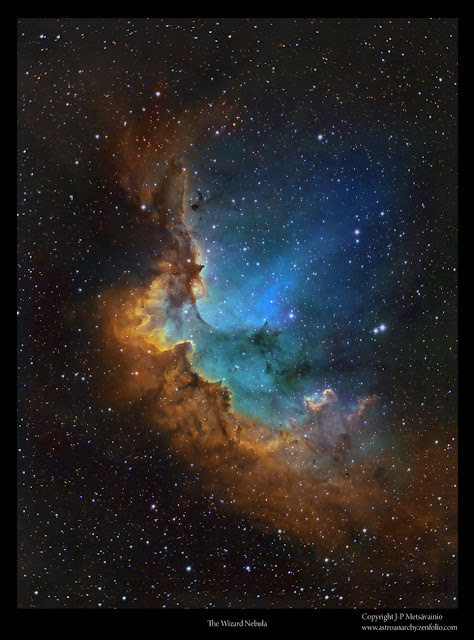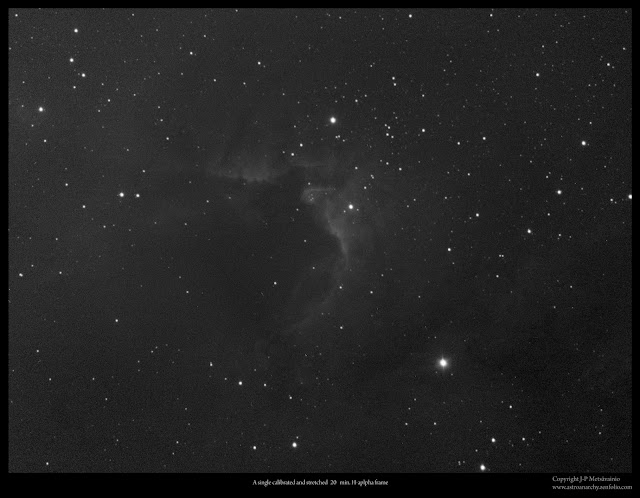COPYRIGHT, PLEASE NOTE
All the material on this website is copyrighted to J-P Metsavainio, if not otherwise stated. Any content on this website may not be reproduced without the author’s permission.
BUY A MUSEUM QUALITY POSTER
BUY A POSTER:https://astroanarchy.zenfolio.com/
Thursday, December 13, 2012
The Pelican Nebula reprocessed
I reprocessed this image since weather doesn't support imaging up here and my processing work flow is somehow different now. My new work flow produces much softer images, I think.
The "Pelican Nebula"
Ra 20h 50m 48s Dec +44° 20′ 60"
R=Sulfur, G=Hydrogen and B=Oxygen.
A closeup
Info
The Pelican Nebula (also known as IC5070 and IC5067) is an Hydrogen emission region associated with the North America Nebula in the constellation Cygnus. The nebula resembles a pelican in shape, hence the name. The Pelican Nebula is , close to Deneb, and divided from its brighter, larger neighbor, the North America Nebula, by a molecular cloud filled with dark dust. Distance is about 1800 light years
Natural color composition from the emission of ionized elements, R=80%Hydrogen+20%Sulfur, G=100%Oxygen and B=85%Oxygen+15%Hydrogen to compensate otherwise missing H-beta emission. This composition is very close to a visual spectrum.
Orientation
The area of interest is marked with a white rectangle. This image shows a large portion of constellation Cygnus, North America Nebula, NGC 7000 at right and Pelican Nebula at left. This image is a small part of very large mosaic image of the Cygnus.
Image showing a light emitted by the ionized Hydrogen, H-alpha
Technical details
Processing work flow:
Image acquisition, MaxiDL v5.07.
Stacked and calibrated in CCDStack.
Deconvolution with a CCDSharp, 30 iterations.
Levels, curves and color combine in PS CS3.
Camera QHY9,
Optics Meade LX200 GPS 12" forced to @ f4.65
Guiding with SXV-AO active optics unit 11Hz
Filters
Baader H-alpha 7nm, 6h, 20 min subs
Baader O-III 8,5nm 1h, 10 min. subs binned 3x3
S-II 1,40h, 10 min subs binned 3x3
Original processing can be seen here:
Ps.
A study about an apparent size in the sky
More info in here:
The size of the Moon (0.5 degrees) is marked at first image in the series.
Wednesday, December 12, 2012
The Wizard Nebula reprocessed
I reprocessed this image since weather doesn't support imaging up here and my processing work flow is somehow different now. My new work flow produces much softer images, I think.
NGC 7380, Sh2-1142, the "Wizard Nebula", in Cepheus
Ra 22h 47m 0s Dec +58° 06′ 00″
R=Sulfur, G=Hydrogen and B=Oxygen.
A closeup
Info
NGC 7380 is a catalog number of the open star cluster inside Wizard nebula, SH2-142.
Nebula locates in constellation Cepheus, about 7000 light years from my home.
Natural color composition from the emission of ionized elements, R=80%Hydrogen+20%Sulfur, G=100%Oxygen and B=85%Oxygen+15%Hydrogen to compensate otherwise missing H-beta emission. This composition is very close to a visual spectrum.
An experimental starless version
This image shows just the gas formation, without stars interfering.
Previous version
same raw data is used here
Technical details:
Processing work flow:
Image acquisition, MaxiDL v5.07.
Stacked and calibrated in CCDStack.
Deconvolution with a CCDSharp, 30 iterations.
Levels, curves and color combine in PS CS3.
Telescope, Meade LX200 GPS 12" @ f5
Camera, QHY9 Guiding, SXV-AO @ 6,5Hz
Image Scale, 0,75 arcseconds/pixel
Exposures H-alpha 15x1200s, binned 1x1
S-II 1x1200s, binned 4x4
O-III 1x1200s, binned 4x4
Beside data here, a color information from an older wide field image is used.
Image can be seen here: http://astroanarchy.blogspot.fi/2011/02/sh2-142-wizard-nebula-wide-field.html
A study about an apparent scale in a sky
Monday, December 10, 2012
Elephant's Trunk nebula reprocessed
Weather doesn't support any imaging, so I reprocessed an older image, the Elephant's Trunk nebula.
Elephant's Trunk
A detail in IC 1396 emission nebula
Image in mapped colors from the light emitted by ionized elements.
Red=Sulfur, Green=Hydrogen and Blue=Oxygen.
Buy a photographic print from HERE
Buy a photographic print from HERE
The elephant's Trunk nebula is a concentration of interstellar gas and dust in the star cluster IC 1396.
This ionized gas region locates in the constellation Cepheus about 2400 light years away.
Formation is coursed by a stellar wind, radiation pressure, from a group of massive young stars.
Natural color composition from the emission of ionized elements, R=80%Hydrogen+20%Sulfur, G=100%Oxygen and B=85%Oxygen+15%Hydrogen to compensate otherwise missing H-beta emission. This composition is very close to a visual spectrum.
Buy a photographic print from HERE
A detail
At the time of imaging, the seeing was very good, HWFM ~2.5
A wide field image of the area
The Trunk formation at bottom middle
More info about this image HERE.
Buy a photographic print from HERE
A Gargoyle of the sky
A Gargoyle?.. See HERE
Technical details
All technical details are with an original image HERE
Sunday, December 9, 2012
The Cave Nebula
I shot this target 29.11. but I'm publishing it now since this one was very hard to process due to its dimness.
Cave Nebula, Sharpless 155 (Sh2-155)
In constellation Cepheus
Red=Sulfur, Green=Hydrogen and Blue=Oxygen.
The Cave Nebula, Sh2-155 or Caldwell 9, is a dim and very diffuse bright nebula within a larger nebula complex containing emission, reflection, and dark nebulosity. It is located in the constellation Cepheus. The reflection, wide band, component can't be seen in my image, since this is a narrowband one.
Distance is about 2400 light years.
Distance is about 2400 light years.
Natural color composition from the emission of ionized elements, R=80%Hydrogen+20%Sulfur, G=100%Oxygen and B=85%Oxygen+15%Hydrogen to compensate otherwise missing H-beta emission. This composition is very close to a visual spectrum.
Orientation in a wide filed image
Area of interest is marked as a white rectangle. More info about this image HERE.
An apparent size of the full Moon is marked at the lower right corner for a scale.
Click for a large image.
Technical details:
Processing work flow:
Image acquisition, MaxiDL v5.07.
Stacked and calibrated in CCDStack2.
Levels, curves and color combine in PS CS3.
Optics, Meade LX200 GPS 12" @ f5
Camera, QHY9
Guiding, SXV-AO, an active optics unit, and Lodestar guide camera 8Hz
Image Scale, ~0,8 arc-seconds/pixel
15x 1200s exposures for the H-alpha, emission of ionized Hydrogen = 5h
Narrowband cahnnels for ionized Oxygen and Sulfur are taken from an older wide field image seen above.
Ps.
A single 20 min. H-alpha frame
Calibrated with Bias corrected flat and Dark masters in CCDStack
1200 seconds of H-aplha light with 12" SCT @ f5 and QHY9 astrocamera.
Image is scaled down 50% from original.
Subscribe to:
Posts (Atom)



























